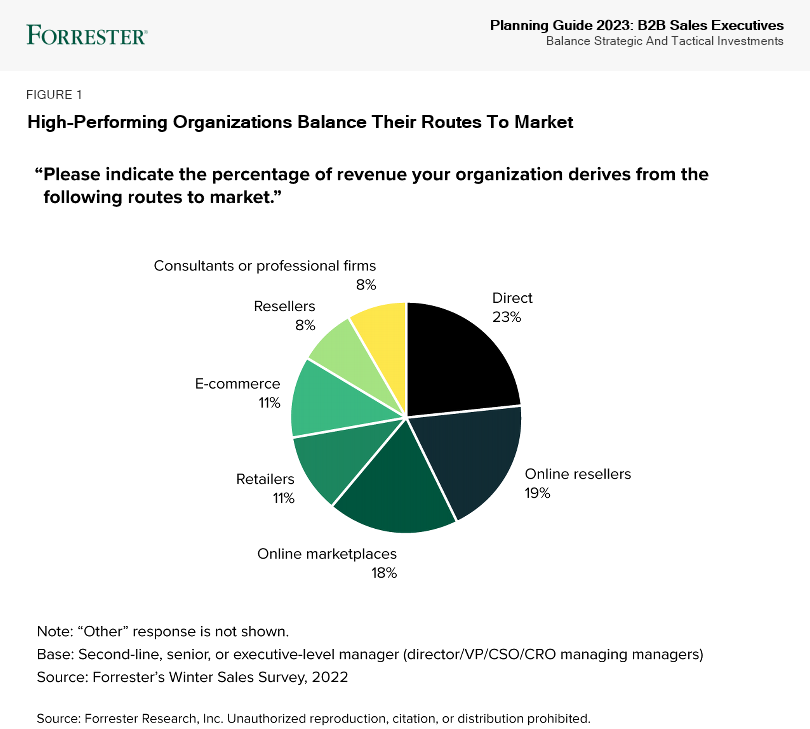Author:
Mike Pregler
Contributors:
Nancy Maluso, Rick Bradberry, Stephanie Sissler, Mallory Icenhower, and Robin Whiting
Balance Strategic And Tactical Investments
B2B sales executives looking ahead to the back half of 2022 and the approach of 2023 can expect an economic outlook that is “gloomy and more uncertain” according to the International Monetary Fund’s July 2022 World Economic Outlook. In response to even a few of the gloomy economic indicators, it would be easy for sales executives to hunker down and prepare to weather the storm. A conservative approach might be to slow hiring, curtail travel, stall investments in technology, and defer training and enablement expenses. Instead, experience from past economic slumps says leaders must balance essential strategic investments and quick-win tactical investments.
Invest In Scalable Growth Initiatives
As sales leaders plan for growth and performance, they should prioritize both short- and long-term initiatives. Achieving quick wins while leading enterprise projects increases the likelihood of continuously hitting bookings targets. In the current climate, sales leaders should invest in:
- Sales transformation. According to Forrester’s Winter Sales Survey, 2022, 72% of first-line sales managers from high-performing organizations agree that sales transformation must be a major initiative in their organization over the next three years. Sales leaders should continue to transform their organizations to a scalable growth model despite disruptions in the economy. The insights-driven sales system provides that scalable growth model. It deemphasizes reliance on a small set of heroic reps or dramatic increases in sales headcount. Instead, it emphasizes investments in scalable growth levers: integrated processes and technologies that are based on data-driven and actionable insights. For each growth lever, balance the investment mix across quick-win and enterprise projects. Prioritize investments that provide high value to buyers and those that increase sellers’ productivity.
- Go-to-market optimization. Use insights from market growth forecasts in combination with insights from internal processes and systems (e.g., pipeline, forecasts, win/loss analysis, customer advisory boards) to assess go-to-market segments. Identify and prioritize the buyers most likely to purchase despite overall economic conditions. Invest in refining the messaging, value proposition, and sales coverage model. Consider changes to quota, compensation, and incentives to drive action to the highest-potential opportunities and customer segments. Invest in seller and channel partner enablement to lead with value-selling approaches aligning the organization’s offerings with the critical business outcomes customers require.
- Seller wellness. Forrester’s Winter Sales Survey, 2022 found that 73% of first-line sales managers report wellness positively impacts productivity and success, although only 59% of those first-line sales managers believe sales leadership is concerned with the physical, emotional, and social well-being of reps. Sales executives should close the perception gap and increase their attention on seller wellness. Incremental shifts in focus across the organization, and especially from sales leadership and first-line sales managers, can increase wellness, engagement, and productivity in the front-line reps.
- First-line sales managers. These individuals are the backbone of a sales organization and are key to boosting seller performance. One of the most effective strategies to improve seller wellness and productivity is regular, effective feedback from first-line sales managers. Forrester’s Winter Sales Survey, 2022 shows that 62% of sales professional individual contributors in B2B organizations report feedback and coaching from their first-line managers is effective and improves performance. However, only 50% of second line sales leaders at B2B organizations are increasing and emphasizing the need for managers to be skilled coaches. Make a strategic investment to improve the feedback and coaching skills and competencies first-line sales managers.
- E-commerce and digital marketplaces. Route-to-market strategies are being evaluated and updated to meet increasing demand from buyers to deliver a more desirable buying experience. The mix is becoming more balanced across direct selling, resellers, online marketplaces, and e-commerce sites. B2B e-commerce reduces friction in the buyer’s journey, which shortens the buying cycle. Forrester’s 2022 B2B E-Commerce Forecast, US estimated that, by 2027, US B2B e-commerce will reach $3 trillion and account for 24% of total US B2B sales. Make strategic investments to expand e-commerce capabilities.

Reduce Spend In Underperforming Go-To-Market Segments
Reallocate resources toward high-potential customers and market segments. However, don’t completely ignore buyers in segments that are negatively impacted by economic challenges. Instead, work with the CMO and your partner ecosystems to develop and invest in lower-cost nurture programs. These will lower current costs and still position your organization to be first in line when recovery comes to these organizations and they are ready to spend again.
Experiment With End-To-End Self-Service Buying
Buyers’ preference for a self-service buying experience continues to climb. Forrester’s 2021 B2B Buying Survey reveals the number of self-directed buying interactions is greater than the number of human interactions (15 and 12, respectively). Companies are increasingly enabling customers to try a product before they buy it or invest less in basic versions first. Often these sales are activated through the company website. As users engage with the product, show them what else they could do with a more robust (paid) version of the product. These other versions are often activated digitally as well. Experiment with pilots of product-led growth opportunities in targeted market segments.
Supplemental Material
Research Methodologies
Forrester’s 2021 B2B Buying Survey was fielded in January and February 2021. This online survey yielded a total of 957 respondents in B2B or B2B2C organizations across Asia Pacific, Europe, and North America: 893 responses were provided by Qualtrics, which fielded the survey on behalf of Forrester; 64 responses were provided by Forrester clients. Quotas were used to control completes by job role, revenue, industry, geography, and purchase complexity. This biennial quantitative research effort began in 2015 to understand buyer habits, preferences, and processes that aid B2B marketers in their efforts to reach and engage buyers. The Qualtrics survey respondent incentives included points redeemable for gift certificates; Forrester respondents received a copy of the findings.
More From Forrester
Invest In Success In 2023
Learn more about how Forrester can help your sales organization gain a competitive edge. Explore our services and resources for B2B sales leaders.